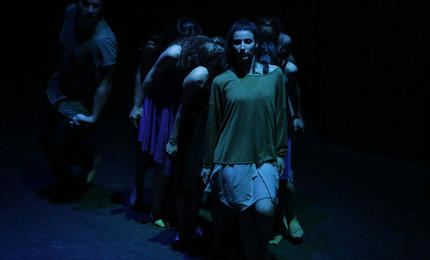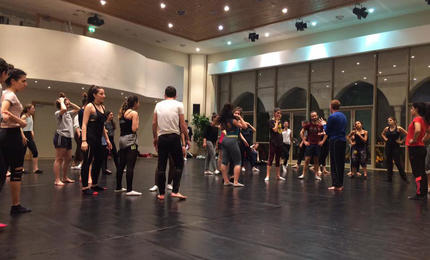Performing arts students shine at international dance festival
Now in its seventh year, the International Dance Day Festival in Lebanon organized by LAU reaches new heights.

Gala performances took place in the Public Garden in Byblos and in Gulbenkian Theatre at LAU Beirut.

562 dance students, including 58 children, took part in performances and workshops conducted on the Byblos campus throughout the one-week festival.
More than 500 dance students from across the country took part in the seventh edition of the International Dance Day Festival in Lebanon held under the theme of gender equality.
Hosted annually by LAU since 2011, the event that ended on April 8 incorporated new features this year with advanced technique and theoretical workshops to cater to the growing number of professional dancers.
“Our festival has always focused on community outreach, which will forever be important, but this year we included more technical workshops and focused on the needs of our own students,” explained festival director Associate Chair of the Department of Communication Arts Nadra Assaf.
“In addition to the physical and technical workshops, there were more lectures, giving us a chance to learn more and ask questions,” said LAU student Yara Nasrany, who was among the first students of the university’s new B.A. in Performing Arts, launched in the fall. Nasrany choreographed and danced in performances staged at the Byblos Public Garden and the Gulbenkian Theatre, Beirut campus, as part of the festival’s closing gala, attended by 400 guests.
“Our students have excelled and are now able to choreograph strong pieces,” enthused Assaf. “We’ve reached a strong point of professionalism with the festival that reflects the high standards of the program as well as the university.”
The U.S.-based dance professionals invited to conduct workshops at the Byblos campus throughout the one-week festival agreed. Christy Chand, who taught a number of jazz workshops, and modern and contemporary dance instructor Nathan Andary participated for the first time. They found the range of technical levels among the dancers to be remarkable. “They really helped each other as opposed to competing, and so the experience was less overwhelming for them than a technique class or audition might’ve been,”Andary said.
This sense of family was also appreciated by Matthew Henley, who had travelled to Lebanon for the festival last year. “Nadra is the mother of this strong dance community that the festival has helped build in the country. It’s a very nourishing experience for me,” said Henley, who performed a contemporary solo during the gala accompanied by the a cappella of student Stephanie Tadros.
“This year, there was much more of a mind-body connection. We learned about how to teach, how to comprehend dance, and how to understand and connect mind and body,” said Tadros, who got to watch a special private dance by Francisco Camacho. The Portuguese dancer―the first to be invited to the festival as a performer rather than an instructor―held five minute one-on-one dance performances with members of the audience in both Byblos and Beirut.
Besides admiring and learning from Camacho’s “vulnerability,” Tadros particularly enjoyed the process of incorporating gender equality into the pieces. “We learned how to interpret and present ideas, like having the girls lift up the boys,” she explained.
Women far outnumbered men in the workshops and the gala performance. This, said LAU instructor of modern and contemporary dance Jimmy Bechara, is the result of the prevailing mentality in the region that associates physical activity for men with sport. “I see dance as an aesthetic sport,” added Bechara, who was among a number of local dancers to give workshops at the festival.
Over the years, the festival and the workshops it offers to dance students across the country at no cost has been instrumental in strengthening their abilities. “I’ve participated in the festival since its first year and got to see how they have grown each time I return. It’s very exciting,” said artist Rain Ross, who this year focused on teaching advanced students how to compose and choreograph creative pieces.
“All the workshops offered were of great value to our students, and that’s why this year I made sure they didn’t overlap,” explained Assaf, whose students, among them Nasrany and Tadros, were thus able to attend almost all the workshops.
In addition to majoring in performing arts, both students are taking second majors, Tadros in business and Nasrany in psychology. “I strongly encourage students to take double majors, or take a minor in performing arts alongside any other major,” said Assaf. “It strengthens both their abilities and their prospects.”
More
Latest Stories
- LAU Nursing Camp Opens Eyes, Hearts and Futures
- Meet Dr. Zeina Khouri-Stevens, Executive Vice President for Health Services
- LAU Family Medicine Graduates to Benefit from a Partnership With Nova Scotia
- AKSOB Assistant Professor Shares Her Vision for the Future of Learning
- LAU Simulation Models Celebrate 20 Years of Learning, Leadership and Service
- The School of Engineering Hosts the Lebanese Electromagnetics Day
- LAU Stands Out on the Sustainability Scores
- Michael Haddad Walks Again for Climate Change and Food Security

